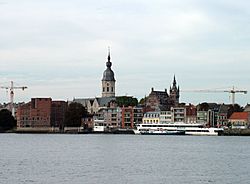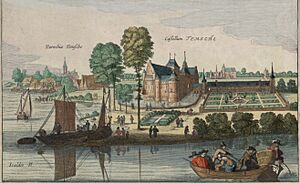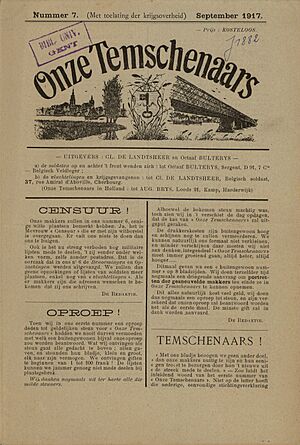Temse facts for kids
Quick facts for kids
Temse
|
|||
|---|---|---|---|
 |
|||
|
|||
| Country | Belgium | ||
| Community | Flemish Community | ||
| Region | Flemish Region | ||
| Province | East Flanders | ||
| Arrondissement | Sint-Niklaas | ||
| Area | |||
| • Total | 39.92 km2 (15.41 sq mi) | ||
| Population
(2018-01-01)Lua error in Module:Wd at line 1575: attempt to index field 'wikibase' (a nil value).
|
|||
| • Total | Lua error in Module:Wd at line 1,575: attempt to index field 'wikibase' (a nil value). | ||
| Postal codes |
9140
|
||
| Area codes | 03 | ||
| Website | www.temse.be | ||
Temse (Dutch pronunciation: [ˈtɛmsə]) is a town in East Flanders, Belgium. It is located on the left side of the River Scheldt.
Temse is known for its beautiful Church of Our Lady. Its tall steeple was designed by a famous sculptor named Adriaan Nijs. Inside the church, you can find the relics of Amalberga of Temse. Nearby is the old "Gemeentehuis" (town hall), which has a musical carillon in its main tower.
The municipality of Temse includes the towns of Elversele, Steendorp, Temse itself, and Tielrode. As of January 1, 2018, about 29,528 people lived in Temse. The total area is 39.92 square kilometers.
Contents
What's in a Name? The Story of Temse
The name Temse comes from old words like Tamisiacum or Tamasiacum. These words were used by the Gallo-Roman people who lived here long ago. The French name for the town, Tamise, also comes from this origin.
The name might have come from a person named *Tamasios* or *Tamisios*. These names could mean "the dark one" or "the dark-haired one."
Another idea is that the name comes from a river or watercourse. The old word *temH-* means "darkness." So, Temse could mean "dark watercourse." This is similar to how other rivers like the Thames got their names.
The town was first called Temsica in the year 941. Over time, its spelling changed to Temseca, Tempseca, and Thamisia. In older Dutch, it was written as Themsche or Temsche, which was the official spelling until 1946.
A Look Back: Temse's History
People have lived in the Temse area since the Stone Age! We have found old items from the Bronze Age, Iron Age, and the time of the Gallo-Romans.
Temse became a Christian area before the year 772. In 864, the Count of Flanders gave the village to the Blandinus Abbey in Ghent. The abbey managed the area until 1460.
A weekly market started in Temse in 1264. Later, in 1519, Charles V added an annual market. Sadly, a big fire in 1684 destroyed much of the village.
In 1912, Temse hosted a special event called the "International Flying Week for Seaplanes." Pilots from Belgium, France, and Germany tested seaplanes. It was a very exciting time for the town!
During the First World War, a local newspaper called Onze Temschenaars helped connect people at home with soldiers fighting. Sixty-three soldiers from Temse died, and eleven others passed away in camps. Two men, Theofiel Maes and Kamiel Van Buynder, were executed in 1917 for being spies. They were helping the Belgian army by sharing information about German troops.
For many years, from 1829 to 1994, Temse was home to the Boelwerf shipyard. This shipyard was very important for the local economy and provided many jobs. It was often called "De Zaat" by the people of Temse.
After the last ship was finished in 1996, the shipyard's land became available. In 2001, a group bought the land to build a new part of town. This new area, called "Nieuw Temse" (New Temse), is now a modern riverside district. It even has the new town hall!
Places to See in Temse
- Temse Bridge: This is a road bridge in Belgium. It was originally designed by the famous engineer Gustave Eiffel, who also designed the Eiffel Tower!
- Church of Our Lady: This church has parts built in both Romanesque and Gothic styles. Inside, you can see beautiful 17th-century decorations.
- Old Town Hall (Temse): This old town hall was finished in 1906. It is built in a style called Flemish Eclectic.
- Onze Temschenaars: Temse used to have its own newspaper with this name.
Gallery
Famous People from Temse
Many interesting people have come from Temse, including:
- Saint Amalberga of Temse: A noblewoman who lived around 741–772.
- Karel Aubroeck: A sculptor (1894–1986).
- Nini Bulterijs: A composer (1929–1989).
- Amaury Cordeel: A racing driver, born in 2002.
- Ghislain Cordeel: Also a racing driver, born in 1999.
- Léon Corthals: A painter (1877–1935).
- Wim De Decker: A footballer, born in 1982.
- Karl Meersman: A cartoonist, born in 1961.
- Charles Nissens: An architect (1858–1919).
- Philips Alexander Nijs: A sculptor (1724–1805).
- Barbara Pas: A politician, born in 1981.
- Edward Poppe: A Catholic priest (1890–1924).
- Jacques Raymond: A singer, born in 1938.
- Ernest Oscar Tips: An aircraft designer (1893–1978).
- Paul van Geert: A linguist, born in 1950.
- Anne Van Lancker: A politician, born in 1954.
- Jan Van Landeghem: A composer, born in 1954.
- Bob Van Reeth: An architect, born in 1943.
- Camille Wauters: A painter (1856–1919).
See also
 In Spanish: Temse para niños
In Spanish: Temse para niños













